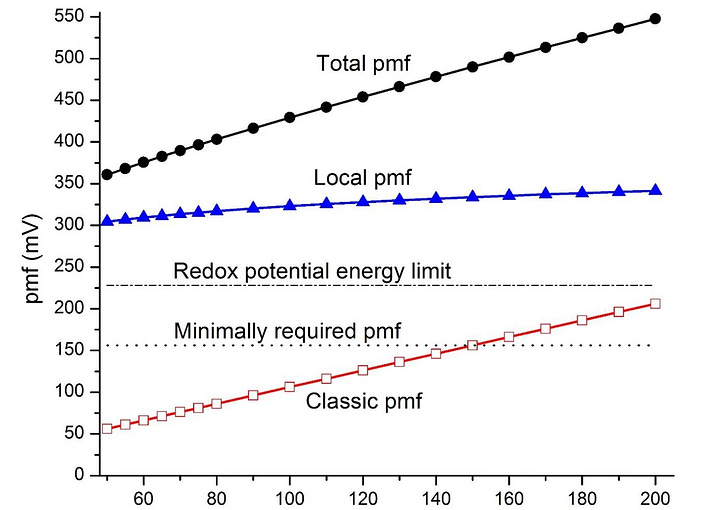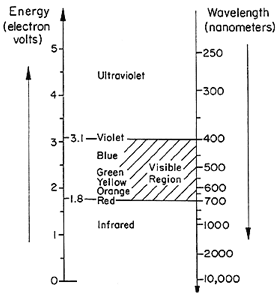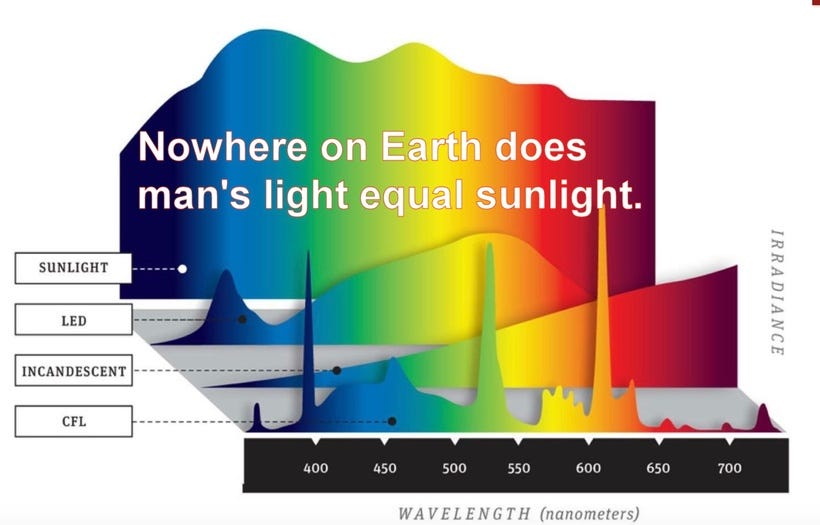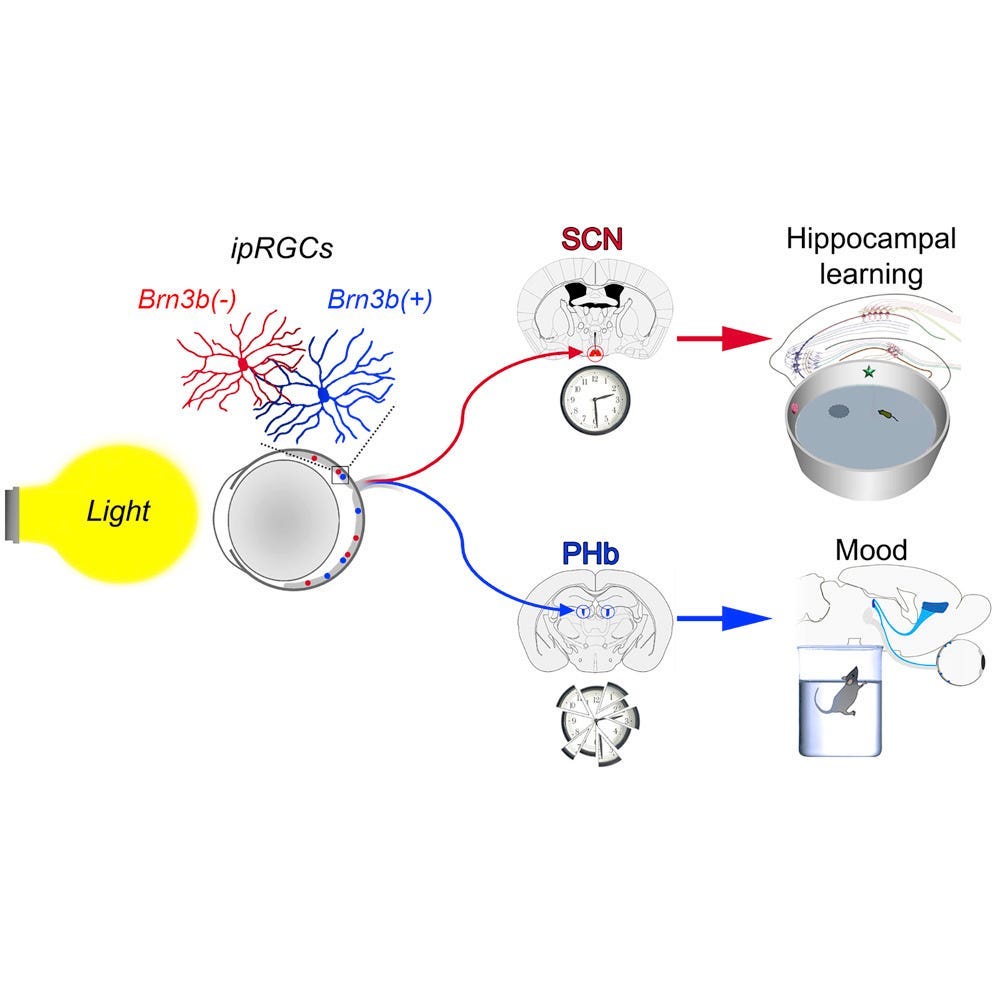4 Ways Sunglasses Harm Our Health
Human photosynthesis | Ocular melatonin | Regulating our mood with light
Here’s what we’ll learn in this article:
1. Two reasons why looking at the Sun is good for our eyes
2. Can wearing sunglasses cause sunburn?
3. Can wearing sunglasses increase our risk for depression?
4. How sunglasses degrade cognitive function
5. Do certain types of glasses increase our EMF exposure?
6. REDUCE EMF 101 Webinar: June 27th
"Your eyes are windows into your body. If you open your eyes wide in wonder and belief, your body fills up with light.
If you live squinty-eyed in greed and distrust, your body is a dank cellar. If you pull the blinds on your windows, what a dark life you will have!”
-Matthew 6:22-23
Do you wear sunglasses because the Sun hurts your eyes?
Could it be that you’ve become sensitive to the Sun because Alan has damaged your eyes?
Who’s Alan?
Artificial Light At Night is one of the reasons we banned Ray-Bans from our lives a long time ago.
Why?
We allowed common sense to conquer our fear of those ‘damaging” UV rays we were always told about, and realized that Alan’s blue rays were to blame.
We thought: if us humans haven’t gone blind after thousands of years of evolution, why would we?
Plus I (Roman) would lose my glasses all the time.
When Bohdanna and I stopped wearing sunglasses, our eyes adapted more quickly than we had expected.
We traded in our dark nights of the soul’s gazing into a cold blue abyss of electronics, and embraced our past Self’s mourning at Sunrise.
Seeing the Sun, even on those cloudy morns, was able to restore the vitality of our eyes.
Two reasons looking at the Sun is beneficial for our eyes:
1. Full spectrum light: The Sun contains even more blue light than our devices. This blue light stimulates cortisol. When we receive cortisol in precise amounts, at the right time of day, this hormone acts to keep us alert, rather than lead to chronic stress. UV from the Sun also creates anti-inflammatory hormones.
While UV and blue light by themselves are toxic, in Sunlight all wavelengths of color are always paired with red. Red light regenerates our retina. We also create ocular melatonin1 when we get red light into our eye.
2. Full spectrum electricity: We harvest energy from the Sun in the same way plants use photosynthesis. While plants use chlorophyll, we use our mitochondria to capture light. This light then allows us to liberate electrons that will then create energy in the form of ATP - only if we see the light, which creates an electric spark in us.
The magic is in the membrane. The electrical charge potential (voltage / force) across our inner mitochondrial membrane is massive. Just like the 120 Volt wiring of our home, our mitochondria are waiting to be plugged into Nature’s power grid: the Sun.


Our inner mitochondrial membrane has a voltage of about 150 millivolts, which is the minimally required pmf (proton-motive force) for ATP synthesis. 2 The minimum energy required to liberate an electron is around 3 electron volts. If we don’t see the Sun, we cut ourselves off from all the free energy around us:

Notice how UV contains the most energy in electron volts (eV) and is also the most demonized?
We don’t need to drive an EV (electric vehicle), EV already drives us.
Could a lack of UV, and overexposure to blue light be one reason why so many are suffering from chronic fatigue?
Is sunburn caused by sunglasses?
Before the advent of sunglasses, the UV (ultraviolet) light from the Sun would be absorbed by our eyes, activating a chemical known as the melanocyte-stimulating hormone (MSH) in blood3, which in turn makes melanin. Melanin makes our skin thicken and go brown in order to give us gradual protection from overexposure to solar radiation and non-native wireless radiation as well.
You may be wondering - how is it that we need the Sun to protect us from the Sun?
Aren’t sunscreens supposed to do that since UV causes cancer?
You might be surprised to know that the studies showing how UV is carcinogenic were all done in lab environments, without the rest of the light spectrum balancing out the “harmful” ultraviolet.
Blue light does not stimulate melanin while UV does, and this is why blue light is associated with epithelial cancers and UV light is not. If you have cataracts, chances are you’ve been overexposed to blue light. Cataracts are nature’s computer glasses, and act as a natural yellow filter that block blue light.4
Melanin also allows us to absorb even more of the beneficial light of the Sun. Recent research shows that when melanin is distributed deeply in our skin, the amount of UV radiation that reaches cells in the epidermis (outer layer) can positively affect folate and B12 levels and repair the DNA in our cells.
Furthermore, UV-B (ultraviolet B) can penetrate our eyes more deeply than our skin, which in turn creates localized inflammation, leading to a stress response that ultimately creates this melanin. This is a “good” kind of acute stress that our bodies used to adapt to our environment.
“Sunglasses alter the solar frequencies to trick the brain by changing the solar frequency spectrum the eye senses into thinking it’s dark and prevent it from producing a hormone (melanin) using nitric oxide pulses that protects against sunburn, according to new research.”
Don’t wind up looking like Kenny:
Is depression caused by sunglasses?
Sunglasses don’t directly cause mental illness. However, light does directly affect our mood. If you’ve ever gotten s.a.d. during the dark days of winter, you’re familiar with how a lack of sunshine can lead to acute changes in mood. This seasonal effect is compounded by an excess of blue light from technology.
Research has shown that blue light disrupts brain signaling, and lowers concentrations of dopamine and melatonin around the skeletal muscle of our pupil.
Why is this important?
Dopamine and melatonin are crucial in maintaining our mood and restoring our brain health, respectively. Low dopamine levels are also associated with mood disorders like depression.
When we’re chronically over-exposed to blue light, the pupils of our eyes become sluggish. As a result, the retinal pathways of our eyes that project to our suprachiasmatic nucleus (SCN) are disrupted. Our SCN regulates daily rhythms of nearly all physiology and behavior. When these rhythms are thrown off, this leads to a cascade of health effects.
Recent research on mice has shown that nerve signals to other parts of our brain, such as the perihabenular nucleus (PHb- shown below) are hindered as a result, leading to mood changes such as depression.4
For more on how blue light contributes to diseases of the brain, you can check out my article here.
Do sunglasses dumb us down?
Mammals rely on the constancy of the solar cycle to maintain not only mood, but cognition as well. Cognitive dysfunction linked to light can be brought on by natural conditions, shift-work, or by traveling across time zones and experiencing jet lag.5
Researchers at Johns Hopkins and Brown University have discovered that our SCN is the main driver of the effects of light on learning and memory (red pathway in diagram above).6
As mentioned above, when we wear sunglasses, the skeletal muscle tone of our eyes weakens, and we lose the ability to regulate dopamine. When control is lost in these central retinal pathways, GABA also will be lowered in the brain.
Why is this important?
Acetylcholine receptors will decrease as well. As this occurs, acetylcholine levels will rise in neural circuits to also lower GABA.7 A deficiency in GABA activity can contribute to certain mental health conditions such as anxiety disorders, schizophrenia, and depression.7
This is why many patients suffering from depression are prescribed GABA, when in reality the root of the issue is not a "chemical imbalance" but an electromagnetic imbalance of light.
Our cognition also drops as acetylcholine receptors are reduced.
Why metal-framed glasses are worse than plastic
As far back as 1989, researchers found8 that metal frames can increase levels of EMFs by your eyes by ten times!
Remember - our bodies already have a natural mechanism to adapt to the Sun. We didn’t come out of our mother’s womb with Ray-Bans on. The only metal frame our eyes use is iron, which is embedded in the hemoglobin of our eyes’ mitochondria, transporting oxygen to our bodies that our cells can “see.”
We were meant to live and breathe under that Great Ball of Fire.
From MIT researcher Stephanie Seneff, Ph.D.:
“Sunglass marketing ads have trained us to wear sunglasses whenever we go outside, ostensibly to protect our eyes from damaging UV rays. However, melanin—which gives your eyes their blue, hazel, green or brown color—already protects them from UV rays.
In fact, the human eye has evolved to deal naturally with sun exposure through antioxidant protection by melanin. I believe it is crucial to get adequate sunlight exposure to the eyes, not just for the sake of eye health but also because critical nuclei in the brain stem make good use of light that enters through the eyes.”
Before we can be the light, we must see the light.
We are more powerful than we know,
Roman & Bohdanna
EMF 101 Reduction Webinar: June 27th
Registration for the second semester of EMF 101 closes Thursday, June 27th.
While many are out partying and posting pictures wearing sunglasses, we’ll be studying like mad scientists with computer glasses each week, so that we can build resilience the rest of the year.
Our second semester will have more of an intimate feel, so now is the perfect time to sign up for some 1:1 attention.
You can also support us at The Power Couple Bookshop - dedicated to making us relearn from our ancestors.
Martínez-Águila A, Martín-Gil A, Carpena-Torres C, Pastrana C, Carracedo G. Influence of Circadian Rhythm in the Eye: Significance of Melatonin in Glaucoma. Biomolecules. 2021 Feb 24;11(3):340. doi: 10.3390/biom11030340. PMID: 33668357; PMCID: PMC7996162.
Lee, J.W. Mitochondrial energetics with transmembrane electrostatically localized protons: do we have a thermotrophic feature?. Sci Rep 11, 14575 (2021). https://doi.org/10.1038/s41598-021-93853-x
Martínez-Águila A, Martín-Gil A, Carpena-Torres C, Pastrana C, Carracedo G. Influence of Circadian Rhythm in the Eye: Significance of Melatonin in Glaucoma. Biomolecules. 2021 Feb 24;11(3):340. doi: 10.3390/biom11030340. PMID: 33668357; PMCID: PMC7996162.
J. Jaeger, S. Berns, S. Uzelac, S. Davis-Conway. Neurocognitive deficits and disability in major depressive disorder. Psychiatry Res., 145 (2006), pp. 39-48.
Davias, N., Griffin, D.W. Effect of metal-framed spectacles on microwave radiation hazards to the eyes of humans. Med. Biol. Eng. Comput. 27, 191–197 (1989). https://doi.org/10.1007/BF02446229











I posted a link to this on facebook and they took it down within 10 seconds as violating community guidelines
I just tried to post it on Facebook as well. Same thing happened. They removed it almost instantly. Great article Roman. I've been trying to share the downfalls of wearing sunglasses and living with LEDs with friends and family. Seems people still think it's 'misinformation' or conspiracy.